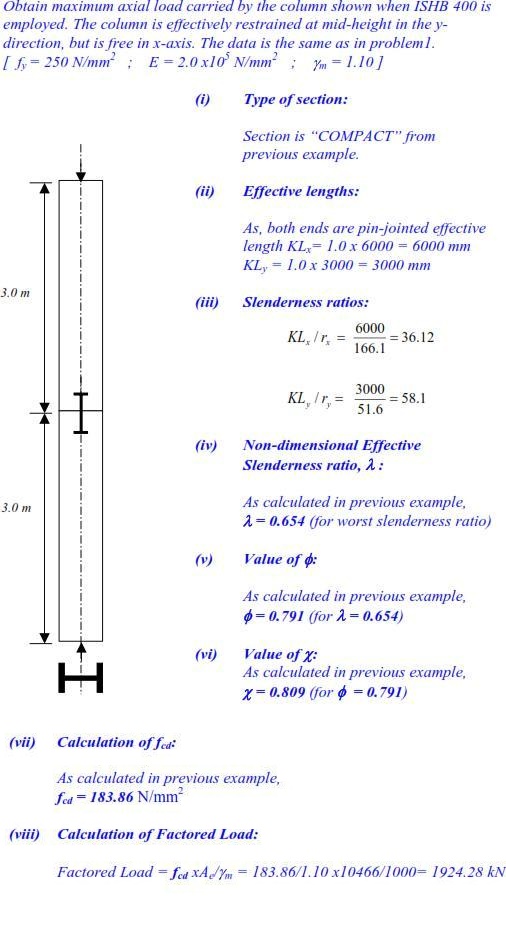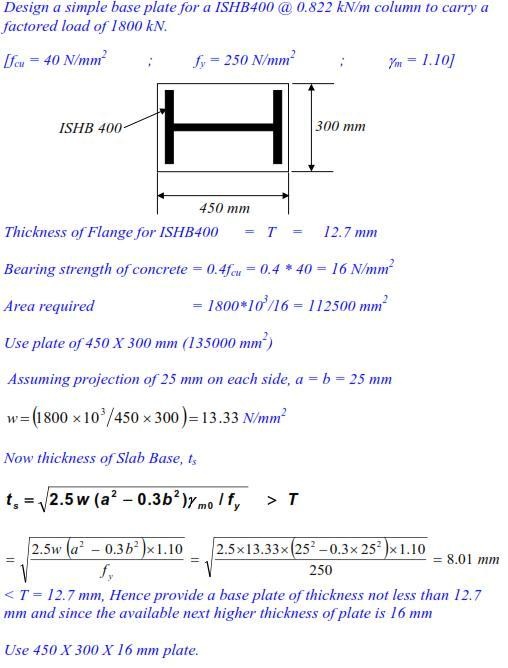Chapter: Civil : Design Of Steel Structures
Important Question And Problems With Answer: Compression Members
Important
Question And Problems With Answer: Compression
Members
1. What do you mean by compression members?
Compression members are the most
common structural elements and it is
termed as columns, struts, posts or stanchions.
They are designed to resist axial compression.
2. Name the modes of failures in a column.
Failure of the cross-section due to
crushing or yielding
Failure by buckling, due to elastic
instability
Mixed mode of failure due to crushing
and buckling
3. Define slenderness ratio
It is defined as the ratio of
effective length l of the column to the
least
radius of gyration r of the column
section.
4. Classify the columns according to the
slenderness ratios.
Short columns - l/r <60
Medium columns - 60< l/r <100
Long columns - l/r >100
5. Distinguish column and strut
Columns are
the vertical members
which carry the
loads to the
beams,
slabs
etc, generally they are used in ordinary buildings.
Struts
are commonly used for compression members in a roof truss; it may either be in
vertical position or in an inclined position.
6. What is meant by stanchions?
These
are the steel columns made of steel sections, commonly used in buildings. 7.
What is Post?
It
is loosely used for a column, but in truss bridge girders, end compression
members are called end posts.
8. What is a boom?
It
is the principal compression member in a crane.
9. State the assumptions that made in
Euler's theory.
The
axis of the column is perfectly straight when unloaded.
The
line of thrust coincides exactly with the unstrained axis of the strut.
The
flexural rigidity EI is uniform
The
material is isotropic
10. Why the lateral systems are provided in
compound columns?
If the plates are not connected
throughout their length of the Built up sections,
lateral systems may be provided, which
act as a composite section. In such cases the
load carrying elements of the built-up compression member in the relative position,
without sharing any axial load.
However when the column deflects, the lateral system
carries the transverse shear force.
11. Name the lateral systems that are used in
compound columns and which is the mostly used one?
Lacing or latticing, Battening or
batten plates, perforated cover plates.
Lacing or latticing is the most common
used lateral system and the sections are flats, angles and channels.
12. What will be the thickness for the single
and double lacing bars?
The
thickness of flat lacing
bars shall not
be less than
one-fortieth of the
length between the inner end rivets or welds
for single lacing, and
one-sixtieth of
the length for double lacing.
13. What is the purpose of providing battens in
compound steel columns?
Batten
plates consist of flats or plates, connecting the components of the built-up
columns in two parallel planes. These are used only for axial loading.
Battening of the composite column should not be done if it is subjected to
eccentric loading or a applied moment in the plane of battens.
14.
What is the thickness of a batten plate?
The
thickness of batten plate shall not be less than one fiftieth of the distance
between the inner most connecting lines of rivets or welds. This requirement
eliminates lateral buckling of the batten.
15.
Where the perforated cover plates are used and mention its advantages?
They
are mostly used in the box sections, which consist of four angle sections so
that the interior of column remains accessible for painting and inspection.
Advantages:
They
add to the sectional area of column and the portions beyond the perforation
share axial load to the extent of their effective area.
There
is economy and fabrication and maintenance
Perforations
conveniently allow the riveting and painting work on the inside portion.
16.
Name the types of column base?
Slab
Base, which is a pinned base. Gusseted base, which is a rigid base.
17.
State the purpose of column base?
The
base of the column is designed in such a way to distribute the concentrated
column load over a definite area and to ensure connection of the lower column
end to the foundation. It should be in adequate strength, stiffness and area to
spread the load upon the concrete or other foundations without exceeding the
allowable stress.
18.
Give the difference between slab base and gusseted base for steel columns.
Slab
base is a thick steel base plate placed over the concrete base and connected to
it through anchor bolts. The steel base plate may either be shop-welded to the
stanchion,else can be connected at the site to the column through cleat angles.
The column is faced for bearing over the whole area.
In a
gusseted base, part of the
load is transmitted from the stanchion
through the gusseted base plate. The gussets and
stiffeners support the base slab against bending and hence a thinner base plate can be
used. The gussets serve for
more or less uniform transmission of the force field from the column to the
base plate. The gussets itself resists the bending as double cantilever beam
supported on flanges of the column.
19.
What is slab base and for what purpose is it provided?
The
base plate connected to the bottom of the column to transfer over wider area is
known as slab base. Column end is machined to transfer the load by direct
bearing. No gusset materials are required.
20.
When the slenderness ratio of compression member increases, the permissible
stress decreases. Why?
The
section must be so proportioned that it has largest possible moment of inertia
for the same cross-sectional area. Also the section has approximately the same
radius of gyration about both the principal axes.


Related Topics